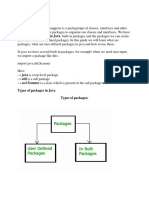0% found this document useful (0 votes)
124 views10 pages.Trashed 1742732429 Java Packages GeeksforGeeks
The document provides an overview of Java packages, explaining their purpose in organizing classes, preventing naming conflicts, and controlling access. It details the structure of packages, how to import classes, and the distinction between built-in and user-defined packages. Additionally, it covers static imports, handling name conflicts, and setting the CLASSPATH for Java applications.
Uploaded by
mivexi9255Copyright
© © All Rights Reserved
We take content rights seriously. If you suspect this is your content, claim it here.
Available Formats
Download as PDF, TXT or read online on Scribd
0% found this document useful (0 votes)
124 views10 pages.Trashed 1742732429 Java Packages GeeksforGeeks
The document provides an overview of Java packages, explaining their purpose in organizing classes, preventing naming conflicts, and controlling access. It details the structure of packages, how to import classes, and the distinction between built-in and user-defined packages. Additionally, it covers static imports, handling name conflicts, and setting the CLASSPATH for Java applications.
Uploaded by
mivexi9255Copyright
© © All Rights Reserved
We take content rights seriously. If you suspect this is your content, claim it here.
Available Formats
Download as PDF, TXT or read online on Scribd
/ 10























































































